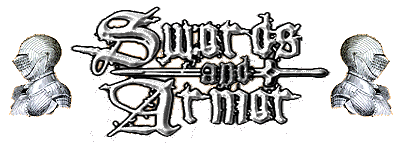
![]() gallant
medieval gentleman, who was a hero and courageous in battle, comes to our mind's
eye when we think of Chivalry. Perhaps an age of romantic history is remembered,
where the courtiers were governed by rules established by a king and the dictates
of his attendants, that formed the fashions and attitudes of the nobility. What
exactly was chivalry and how did it start? To understand Chivalry, one must consider
not only its military but social and religious implications. The history of Chivalry
stretches over several centuries with the knight evolving from a religious defender
of the poor and widowed into the gaudier court soldier who alternated between pageantry
and bloody battles.
gallant
medieval gentleman, who was a hero and courageous in battle, comes to our mind's
eye when we think of Chivalry. Perhaps an age of romantic history is remembered,
where the courtiers were governed by rules established by a king and the dictates
of his attendants, that formed the fashions and attitudes of the nobility. What
exactly was chivalry and how did it start? To understand Chivalry, one must consider
not only its military but social and religious implications. The history of Chivalry
stretches over several centuries with the knight evolving from a religious defender
of the poor and widowed into the gaudier court soldier who alternated between pageantry
and bloody battles.
THE MILITARY ASPECTS
The word chivalry originated in the Latin caballarius and the Greek kaballes < French cheval or cavalerie < Italian cavallo or cavalleria < cavalier or cavaliere evolving to the English cavalry. The literal translation means "an inferior riding or pack horse, a nag" This was not the commander in chief, by any means, but was a slowly evolving, better equipped soldier than the foot soldier that he followed in that time of history. The oldest word associated with "knight" is the Medieval Latin milles or soldier. Old English cniht (Middle English kniht) means boy or retainer and the Old German knecht, means servant or lad.
The knight, or chevalier, was the professional soldier of his time and was defined by the use of the horse, weapon and affiliation. The weapon of the chevalier became specific for the use of the horse. In early Roman times, a swordsman on foot needed a sword that was short and broad. This enabled him to use it both as a defensive and as an offensive weapon in a compact area. A swordsman on a horse, however, needed an additional weapon. Spears enabled the horseman to develop a downward thrust that could be devastating to a foot soldier unprepared for the quick movement of calvary. Spears, or lances, enabled the soldier to reach far beyond his horse, protecting both of them. The sword remained in use for closer encounters.
THE SOCIAL ASPECTS
In addition to the cost of the armor and the horse, a professional knight was also expected to provide the upkeep of servants to aid him. Very few knights actually had full suits of armor or the full entourage of servants necessary unless they were attached to a very wealthy patron, usually a baron or baronet in groups of about ten knights. These different groups would attach a pennant to the end of their lances which became their flag, to distinguish each other on the battlefield. The individual knight was usually paid in land for a fixed amount of military service. These lands became hereditary thus spawning its own class of nobility. However, a son was not automatically a knight. These would be soldiers were sent to courts to be trained in gentility as well as arms and, eventually serve as squires. Through an act called "dubbing", usually around the age of twenty-one, a squire was made a knight. Any knight could dub another as long as the candidate had met the three qualifications of birth right, training, and age.
THE RELIGIOUS ASPECTS
Prior to the crusades, during feudal times, the onslaught of barbarism that was descending on Europe polarized the Church clergy to extract a vow from the feudal lords, who were barely more civilized than the forces that threatened them. This vow is known as the "Truce of God". This bound these rulers to primarily use their defenses to protect the weak and the helpless, especially women and orphans, and the churches, from the raids of the foreign enemies instead of feuding with each other. Since this was a religious vow considered very sacred in the Medieval times, this ennobled the common soldier almost to the status of a monk. Thus, the beginning of Chivalry was based on a vow to God, in the service of God, for the protection of the weak and poor, as Jesus had taught the Church in the Sermon on the Mount.
The crusades were a natural progression. As the knights grew in numbers and became more organized, the defensive beginnings of the Chivalric age gave way to a more offensive position. As outposts of European Christianity became threatened, the knights, with promises of eternal rewards, were sent to Jerusalem to eradicate Muslim forces which were dominating the birthplace of Christianity and threatening the safety of pilgrims to these sacred sites.
fantasy weapons wearable armor
wearable armor Scottish Samurai
shields SCA Civil War History of the Knights
Warning !
All photographic images, copy and all other portions of this web site are protected
by U.S. copyright laws. Image theft and misuse will result in prosecution to the full extent of the
law ...
damages up to $100,000 per incident - visit www.copyright.gov